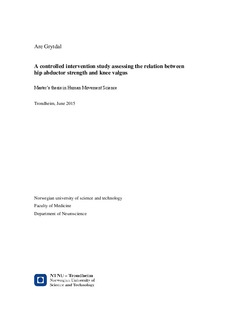A controlled intervention study assessing the relation between hip abductor strength and knee valgus
Master thesis
Permanent lenke
http://hdl.handle.net/11250/300745Utgivelsesdato
2015Metadata
Vis full innførselSamlinger
Sammendrag
Background: Anterior cruciate ligament (ACL) injury is a common and severe lower
limb injury. Knee abduction moment has been associated with risk of non-contact
ACL injury, and knee valgus angle has been reported as part of the non-contact ACL
injury mechanism. Fatigued and weak hip abductors have been correlated with
increased knee abduction moment and knee valgus angle. Strengthening the hip
abductor muscles might play an important role in ACL injury prevention.
Purpose: To prospectively assess the relation between changes hip abductor strength
and knee valgus and knee abduction moment.
Study Design: Controlled intervention study
Methods: 31 amateur female handball players with reduced knee control (mean±SD;
age, 22.3±2.7 years; height 170.0±4.8 cm; weight, 72.6±8.3 kg) were divided into
intervention (n=17) and control (n=14) groups. The intervention group performed a
short-duration hip abductor resistance and sensorimotor control training program
2d/w for eight weeks in combination with their team training. Hip abductor strength
was measured by handheld dynamometry at baseline, mid-protocol and post-test.
Lower-limb kinetics and kinematics were calculated for the counter movement jump,
in-jump landing and bilateral one-legged landing at baseline and post-test. Mixed
design repeated measures analysis of variance (ANOVA) was performed to compare
changes between groups.
Results: The intervention group did not significantly increase in hip abductor strength
compared to the control group in any of the four strength tests (p>0.05). The
intervention group significantly reduced their knee abduction moment compared to
the control group in the take-off of the CMJ in the left (F(1,21)=4.4, p=0.05, effect size
(ES)=0.20) and the right leg (F(1,21)=4.9, p=0.041, ES=0.22). Increased hip abductor
strength was not related to reduced knee abduction moment and knee valgus angle
when comparing players increasing in strength to players not increasing in strength in
the intervention group (p>0.05).
Conclusion: Hip abductor strength increase was not related to reduced knee valgus.
However, the intervention group did not significantly increase hip abductor strength
compared to the control group. The hypothesis that increased hip abductor strength
results in reduced knee valgus cannot be refuted, but this study could support the
notion that solely focusing on strengthening the hip abductors is insufficient to reduce
knee valgus.
